Jasmine tea, a delicate and aromatic beverage, has captivated tea enthusiasts for centuries with its floral aroma, smooth taste, and numerous health benefits. Originating from China during the Song Dynasty (960-1279 CE), this tea has a rich history steeped in tradition and cultural significance. In this comprehensive guide, we’ll explore the origins, production methods, varieties, health benefits, and cultural significance of jasmine tea, as well as tips for brewing and enjoying this beloved beverage.
Origins and History
The exact origins of jasmine tea are shrouded in legend and folklore, but historical records trace its roots back to China’s Jiangxi Province during the Song Dynasty. It is believed that it was first created by tea artisans who infused green tea leaves with fresh jasmine blossoms to impart their fragrance and flavor. Over time, the popularity of this tea spread throughout China and beyond, becoming a cherished beverage enjoyed by emperors, scholars, and commoners alike.

Jasmine tea production traditionally took place in the city of Fuzhou in Fujian Province, where the mild climate and fertile soil provided ideal conditions for growing jasmine flowers. Skilled artisans handpicked fresh jasmine blossoms during the summer months when they were in full bloom and at their most fragrant. These blossoms were then carefully layered with green tea leaves in a process known as scenting or perfuming, allowing the tea to absorb the floral aroma and flavor of the jasmine flowers.
As trade routes expanded during the Ming (1368-1644 CE) and Qing (1644-1912 CE) Dynasties, jasmine tea became a sought-after commodity in international markets, particularly in Europe and the Middle East. Its delicate aroma and refreshing taste earned it a reputation as the “champagne of teas” and a symbol of elegance and refinement.
Production Methods
The production of jasmine tea is a labor-intensive process that requires meticulous attention to detail and time-honored techniques. While modern methods have streamlined some aspects of production, many tea artisans still adhere to traditional practices to preserve the quality and authenticity of this tea.
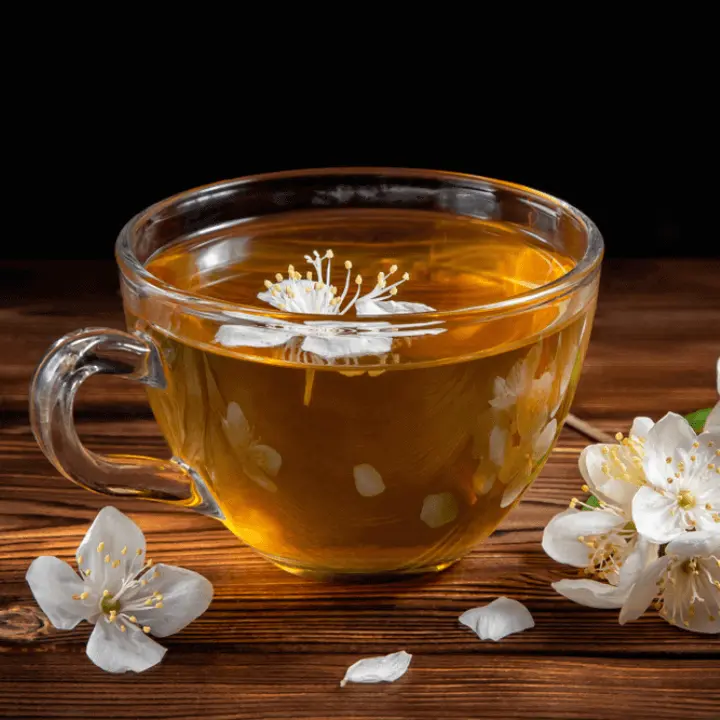
Harvesting
Jasmine tea production typically begins with the harvesting of green tea leaves in the early spring. These leaves are carefully selected for their size, shape, and quality, as they will serve as the base for the tea.
Scenting
Once the green tea leaves have been harvested, they are withered to reduce moisture content and make them more pliable. Meanwhile, fresh jasmine blossoms are handpicked from jasmine plants in bloom and stored until they reach their peak fragrance.
Layering
In the traditional method of scenting, alternating layers of green tea leaves and jasmine blossoms are placed in large trays or baskets. The layers are carefully stacked to allow the tea leaves to absorb the aroma of the jasmine flowers over several hours or even days.
Drying
After the tea leaves have absorbed the desired amount of jasmine fragrance, they are gently dried to remove excess moisture and preserve their flavor. This drying process may involve air drying or pan firing, depending on the specific requirements of the tea.
Final Processing
Once dried, the jasmine-scented tea leaves undergo final processing steps, such as sorting, grading, and packaging. The finished tea is then ready to be enjoyed or exported to markets around the world.
While traditional methods of this tea production remain prevalent in regions like Fujian Province, modern techniques, such as machine scenting and vacuum sealing, have been introduced to increase efficiency and meet growing demand. However, many tea enthusiasts believe that the best-quality jasmine tea is still produced using time-honored methods that prioritize craftsmanship and attention to detail.
Varieties of Jasmine Tea
Jasmine tea comes in several varieties, each distinguished by the type of green tea used as the base and the quality of the jasmine flowers. Some of the most popular varieties of this tea include:
Jasmine Green Tea
This is the most common type of jasmine tea, featuring green tea leaves scented with jasmine blossoms. It has a light, refreshing flavor with subtle floral notes and a smooth finish.
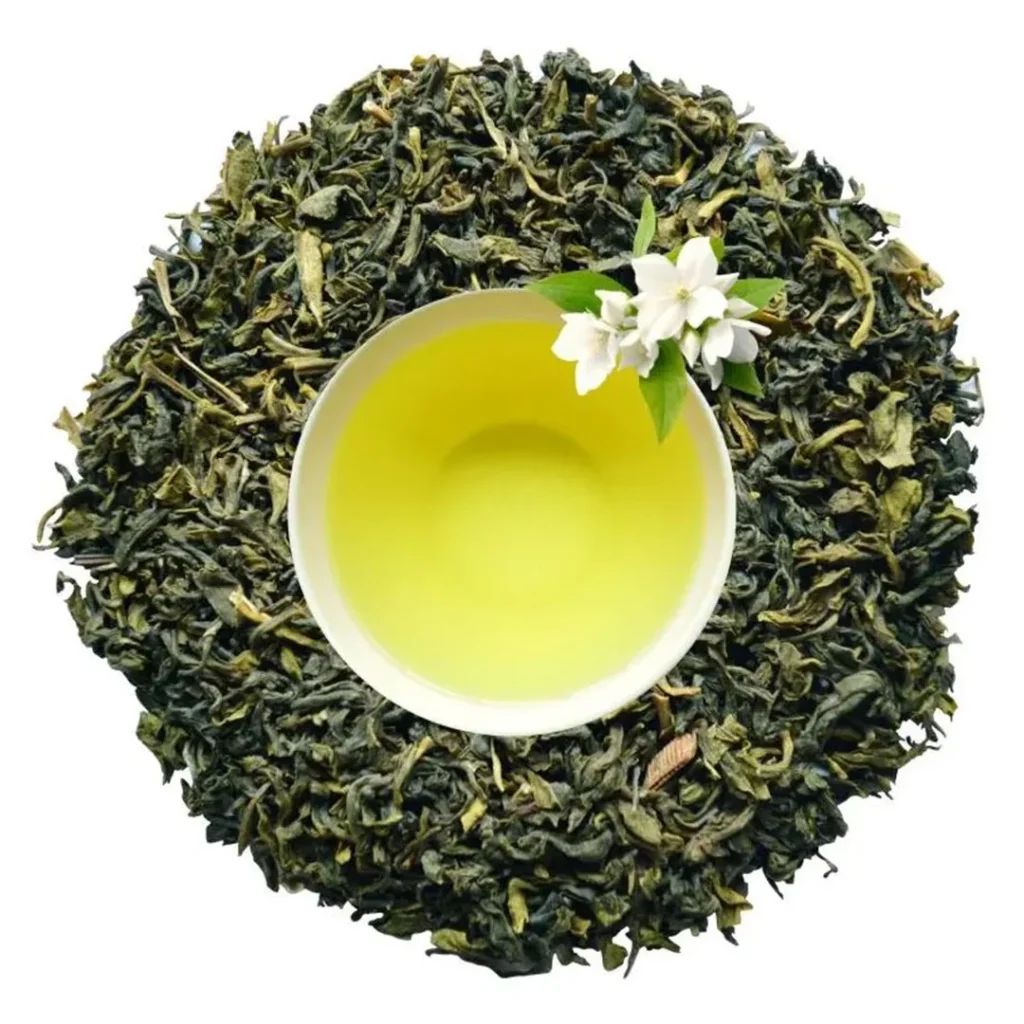
Also Read: 10 Benefits of Green Tea That Are Miraculously Healthy!
Jasmine Pearl Tea
Also known as Jasmine Dragon Pearls, this variety consists of hand-rolled green tea leaves that unfurl when steeped, revealing jasmine blossoms hidden within. It has a more intense aroma and flavor compared to traditional jasmine green tea.
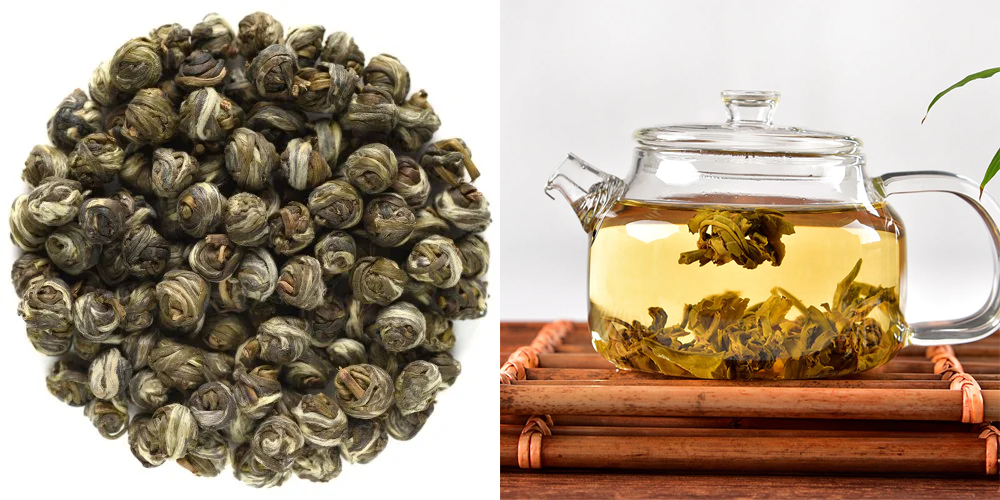
Jasmine White Tea
Made from delicate white tea leaves, this variety offers a lighter and more subtle taste profile with delicate floral notes. It is prized for its delicate aroma and smooth, mellow flavor.
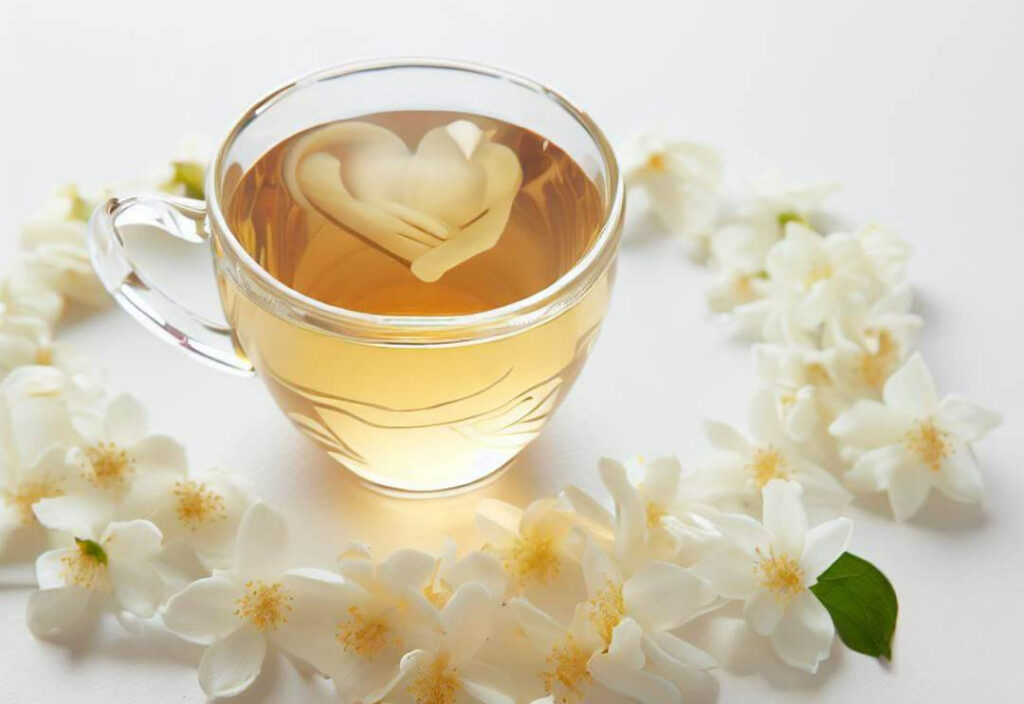
Jasmine Oolong Tea
Combining the floral fragrance of jasmine with the complex flavors of oolong tea, this variety offers a unique and sophisticated taste experience. It has a rich, creamy texture with floral and fruity undertones.
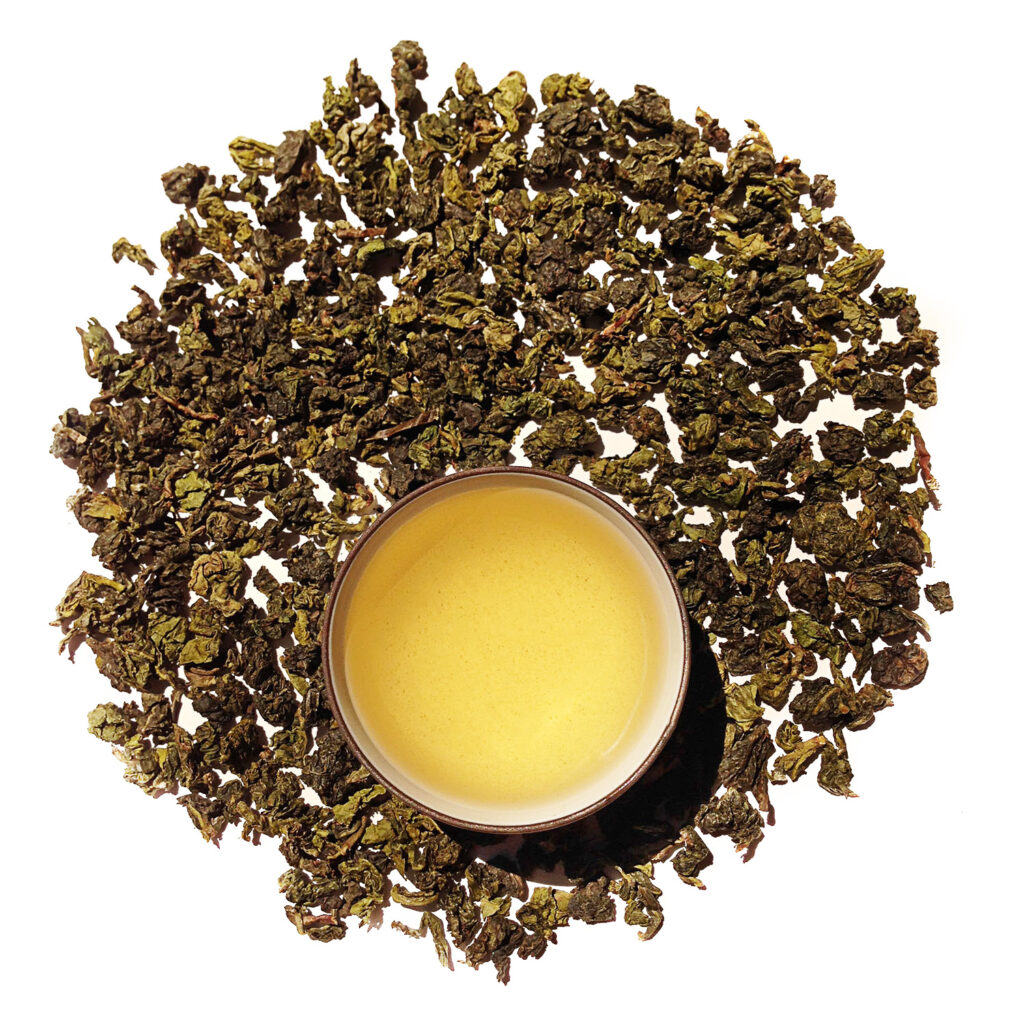
Jasmine Black Tea
While less common than other varieties, jasmine black tea features robust black tea leaves scented with jasmine blossoms. It has a bold, full-bodied flavor with hints of sweetness and floral aroma.
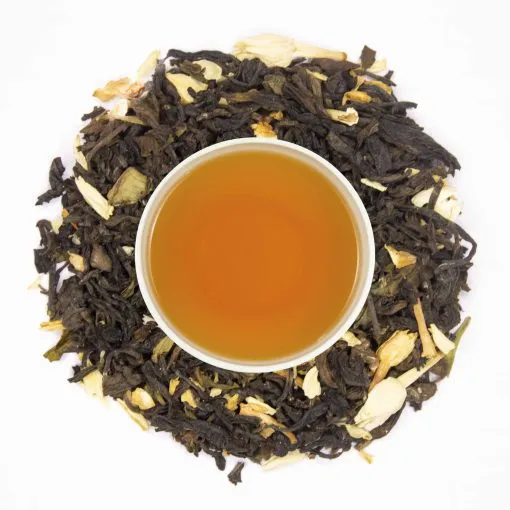
Each variety of jasmine tea offers a unique sensory experience, allowing tea enthusiasts to explore different flavor profiles and find their preferred brew.
Health Benefits of Jasmine Tea
In addition to its delightful flavor and aroma, jasmine tea offers a wide range of health benefits attributed to its antioxidant properties, vitamins, minerals, and other bioactive compounds. Some of the amazing health benefits of jasmine tea are as follows.
Antioxidant Protection
Jasmine tea is rich in antioxidants, such as catechins, flavonoids, and polyphenols, which help protect cells from oxidative damage caused by free radicals. Antioxidants may reduce the risk of chronic diseases, including heart disease, cancer, and neurodegenerative disorders.
Heart Health
Regular consumption of jasmine tea may support heart health by lowering LDL cholesterol levels, reducing blood pressure, and improving blood vessel function. The polyphenols and catechins found in this tea have been shown to have cardioprotective effects and may reduce the risk of heart disease and stroke.

Digestive Support
Jasmine tea’s soothing properties can aid in digestion and alleviate digestive discomfort, such as bloating, gas, and indigestion. It may help stimulate digestion, reduce inflammation, and promote overall gastrointestinal health.

Weight Management
Some studies suggest that jasmine tea may aid in weight management by boosting metabolism, increasing energy expenditure, and promoting fat burning. Drinking this healthy beverage as part of a healthy diet and lifestyle may help support weight loss and maintenance goals.

Immune Support
The antioxidants and vitamins found in jasmine tea can strengthen the immune system and help defend the body against infections and illness. Regular consumption of this tea may reduce the frequency and severity of colds, flu, and other common infections.

Mental Well-Being
The aroma of jasmine tea has calming and uplifting effects on mood and mental well-being. It may help reduce stress, anxiety, and depression, promote relaxation, and improve overall cognitive function and emotional resilience.

Skin Health
Jasmine tea’s antioxidant properties can benefit skin health by protecting against free radical damage and premature aging. It may help maintain skin elasticity, reduce inflammation, and promote collagen production for smoother, more youthful-looking skin.

Oral Health
The antibacterial and anti-inflammatory properties of jasmine tea may promote oral health by preventing tooth decay, gum disease, and bad breath. Drinking it regularly may contribute to healthier teeth and gums and fresher breath.

Respiratory Health
The aroma of jasmine tea has been traditionally used to relieve respiratory symptoms, such as coughs, congestion, and sore throat. Inhaling the fragrance of this tea may help open up the airways and promote easier breathing.

Longevity
In traditional Chinese medicine, jasmine tea is believed to promote longevity and vitality by strengthening the body’s vital energy, or qi, and balancing the yin and yang energies. While scientific evidence supporting this tea’s role in longevity is limited, its antioxidant-rich composition and potential effects on various aspects of health suggest that it may contribute to a longer and healthier life.

Cultural Significance
Jasmine tea holds significant cultural and symbolic importance in China and other regions where it is consumed. In Chinese culture, this tea is often associated with hospitality, friendship, and good fortune, making it a popular beverage for social gatherings and celebrations.
Jasmine tea is also deeply intertwined with Chinese tea ceremonies, where it is served as a gesture of respect and reverence to guests. The delicate aroma and flavor of this beverage are believed to enhance the tea-drinking experience, creating a sense of harmony and balance between the mind, body, and spirit.
In addition to its cultural significance, jasmine tea has inspired artists, poets, and writers throughout history, who have praised its beauty, fragrance, and elegance in their works. From traditional Chinese paintings depicting jasmine flowers to modern literary references in poetry and prose, this tea continues to inspire creativity and evoke a sense of tranquility and serenity.
Brewing and Enjoying Jasmine Tea
Brewing jasmine tea is a simple yet rewarding process that allows you to savor its delicate aroma and flavor to the fullest. Here are some tips for brewing and enjoying it.
- Select high-quality tea made from fresh green tea leaves and fragrant jasmine blossoms for the best flavor and aroma.
- Use fresh, filtered water to brew the tea, as impurities in tap water can affect the taste and clarity of the tea.
- Heat water to the optimal temperature for brewing the tea, typically around 175-185°F (80-85°C) for green tea. Avoid boiling water, as it can scald the tea leaves and result in a bitter taste.
- Steep the tea for 2-3 minutes to extract the delicate flavors and aromas of the tea leaves and jasmine blossoms. Adjust the steeping time according to personal preference for stronger or milder tea.
- Before taking a sip, take a moment to inhale the fragrant aroma of the jasmine tea, allowing the floral notes to tantalize your senses and evoke a sense of relaxation and well-being.
- Pour the brewed jasmine tea into a teacup or glass, and savor each sip slowly, allowing the flavors to unfold on your palate. This tea can be enjoyed hot or cold, depending on personal preference and the season.
- This tea pairs well with light and aromatic dishes, such as steamed dumplings, sushi, salads, and fruit desserts. Experiment with different flavor combinations to enhance your tea-drinking experience.
The Concluding Lines
Jasmine tea is more than just a beverage; it’s a sensory journey through time and tradition, offering a delightful blend of fragrance, flavour, and health benefits. Whether enjoyed as a daily ritual or shared with friends and loved ones, jasmine tea continues to captivate tea enthusiasts around the world with its timeless charm and elegance. By exploring the origins, production methods, varieties, health benefits, and cultural significance of jasmine tea, we gain a deeper appreciation for this beloved beverage and its enduring legacy in tea culture. So brew a pot of jasmine tea, take a moment to savor its exquisite aroma, and embark on a journey of tranquillity and well-being with each sip. Hopefully, you enjoyed reading and knowing about this topic. If you really did then let us know your valuable thoughts in the comment section down below. Thanks for visiting and appreciating our work.
